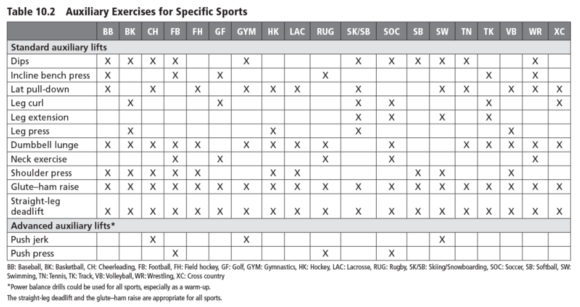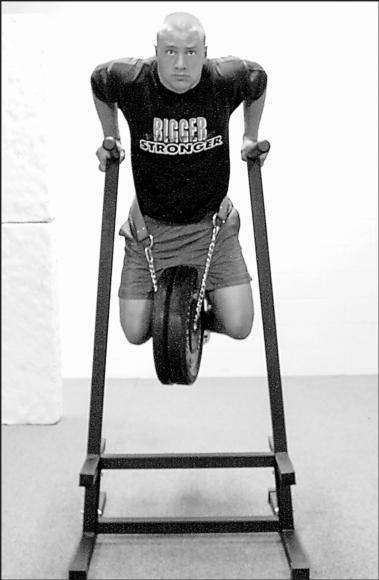Master standard and sport-specific auxiliary lifts
This is an excerpt from Bigger Faster Stronger 3rd Edition by Greg Shepard,Kim Goss.
Auxiliary lifts are special exercises that are sport specific and help prevent injuries common in a sport. Chin-ups and lat pull-downs would be sport-specific exercises for baseball players because the latissimus dorsi muscles of the upper back internally rotate the upper arms. Incline bench presses would be sport specific to a shot putter or boxer because of similar movement patterns, and neck exercises are extremely important to prevent injuries in football and wrestling. Neck exercises, however, are not as important to basketball or baseball players.
Auxiliary exercises receive less emphasis than core lifts. They are best performed after the core lifts and are only prescribed for about two sets of 10 reps. Larger groups of athletes with limited facilities may, however, find it necessary to rotate athletes between core lifts and auxiliaries as outlined in chapter 15, Organization and Weight Room Design.
Select no more than five auxiliary exercises to perform during a single week. We've found that performing more than five exercises will cause problems because athletes will not have enough time and energy to do the necessary sprinting, endurance, flexibility, plyometric, agility, and technique work required for their sport. The ultimate objective is for athletes to reach their potential, so compromises have to be made. As such, select only those exercises that will effectively contribute to the ultimate objective.
Which auxiliary exercises are best? Our BFS clinicians rated 100 auxiliary lifts and came up with a list of preferred exercises by young athletes. From an injury prevention perspective, it would be wise to select at least one auxiliary exercise that works a body part that is commonly injured in an athlete's chosen sport. Here are a few common injury sites for several popular sports that could benefit from auxiliary exercises:
- American football: knee and hamstrings
- Badminton: shoulder, elbow, and wrist
- Baseball: shoulder and elbow
- Baseball: ankle and knee
- Cycling: knee and lower back
- Distance running: knee and ankle
- Field hockey: hamstrings and ankle
- Ice hockey: shoulder and adductor
- Soccer (football): ankle and knee
- Swimming: shoulder and neck
- Tennis: shoulder and elbow
- Track and field (sprints): hamstrings and knee
Another important factor to consider regarding sports injuries is the frequency with which the sport is played. Professional athletes and elite amateur athletes must participate in much longer and harder workouts than the average amateur athletes. It's therefore not uncommon that many elite athletes have required surgery to continue playing their sport, especially those in contact sports such as football, but no sport is safe. One survey of 1,144 golfers found that golfers who had a handicap under 10 experienced a much higher rate of injury than those with a handicap over 18. That said, a great resource that discusses injuries in 24 sports is Epidemiology of Sports Injuries by Caine, Caine, and Lindner (1996). It covers 24 sports and activities and discusses injury incidence, injury characteristics, injury severity, and injury risk factors.
We have divided these auxiliary lifts into two categories - standard and advanced.
Standard Auxiliary Lifts
Standard auxiliary exercises are relatively safe, easy to perform, and require less coaching and lifting expertise than the advanced auxiliaries. The incline press is the only auxiliary exercise in our list that requires a spotter. Of course, coaches must ensure their athletes can perform these exercises correctly and provide supervision for all workouts.
Most high school and college gyms already have all the equipment necessary to perform these exercises. One exception is the glute - ham machine or back extension bench, needed to perform back extensions and glute - ham raises. The glute - ham raise is also among the BFS advanced auxiliaries.
Table 10.1 lists all the auxiliary exercises and the sports for which they are the most appropriate. Table 10.2 shows how to organize the standard auxiliary exercises in your weekly training sessions.


Dips
A standard exercise for gymnasts, skiers, cheerleaders, and swimming, dips are an effective exercise to develop the shoulders, pectorals, and triceps (figure 10.1).

Dips are an effective exercise to develop the shoulders, pectorals, and triceps.
Start Position
Grasp the dip handles and step up so that your arms are extended and directly under your shoulders. Look straight ahead.
Action
Slowly lower yourself so that your arms extend below parallel and then return to the start; athletes with exceptional mobility and good posture can perform the exercise throughout a longer range of motion. As this exercise becomes easy, add resistance by using a dip belt.
Breathing
Inhale as you lower your body and exhale as you straighten your arms.
Learn more about Bigger Faster Stronger, Third Edition.
More Excerpts From Bigger Faster Stronger 3rd EditionSHOP

Get the latest insights with regular newsletters, plus periodic product information and special insider offers.
JOIN NOW


